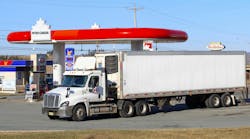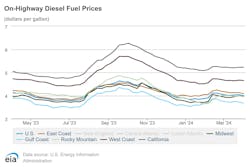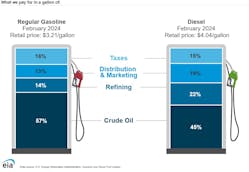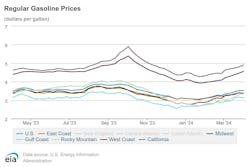Diesel prices across the U.S. have remained largely static since February, but the national average recently dipped beneath $4 for the first time in nearly two months, according to the U.S. Energy Information Administration. The current diesel price national average sits at $3.996 per gallon, 3 cents lower than last week and 10 cents lower than this time last year.
This price decrease was echoed across the country, as diesel pump prices fell by a few cents in most regions. But in California, diesel fell by less than a cent to $5.221 per gallon. The New England subregion and the West Coast followed each falling by only 1 cent to $4.305 and $4.651 per gallon, respectively.
Meanwhile, the Lower Atlantic sub-region saw a more significant diesel price decrease of 5 cents to $3.990, followed by the Gulf Coast’s price drop of 4 cents to $3.670 per gallon and the East Coast’s of 4 cents to $3.670. Altogether, the Gulf Coast is still the cheapest area to buy diesel fuel at $3.670 per gallon, while California is the most expensive at over $5.
Additionally, the EIA noted some changes in the factors driving diesel prices from January (retail price of $3.85 per gallon) to February (retail price of $4.04 per gallon) 2024. While the percentage of diesel costs per gallon that go toward crude oil and taxes have not changed and still comprise 45% and 15% of fuel costs, respectively, the allotment surrounding distribution, marketing, and refining has shifted. Refining constituted 22% of the price of a gallon of fuel in February 2024, 3% more than in January, which comes out to 88 cents of February’s total diesel cost per gallon. However, the cost of allotment to distribution and marketing fell from 21% to 19%, which equates to 76 cents.
In comparison, the AAA motor club’s current diesel average is $4.018, roughly 2 cents more than the EIA’s reckoning. This price is also 3 cents cheaper than last week’s diesel average of $4.042 and 21 cents cheaper than the average last year of $4.222.
Gasoline price spike wavers at $3.517 per gallon
The U.S. national average for gasoline prices broke the streak of consistent price increases it has upheld since Jan. 15. Nationwide, gas prices decreased by less than a cent from last week to $3.517, a sum up 2 cents from last year. However, this was not the case in every region across the country.
Generally, gas prices rose and fell at a rate of 0-10 cents since last week. Prices decreased less than a cent on the East Coast, reaching $3.382 per gallon, while the Midwest’s gas costs fell 4 cents to $3.366, and the Gulf Coast’s costs decreased 6 cents to $3.116 per gallon.
Meanwhile, the price rose by 5 cents for the Rocky Mountain region ($3.351 per gallon), 9 cents for the West Coast overall ($4.556), and 10 cents for California. In the western state, prices have nearly reached $5 per gallon of gas, at $4.904. In total, the Gulf Coast is still the cheapest place to buy gas, at $3.116 per gallon, while California is the most expensive, at $4.904.
To compare, the AAA gas average is currently at $3.536 per gallon, the same as last week and 2 cents less than the EIA’s figure. This is also 3 cents more expensive than last year’s average at this time. In a press release, the AAA attributed the recent fuel cost volatility to global events.
“Uncertainty of the impact of Ukraine’s targeting of Russia’s oil infrastructure likely spiked oil prices recently,” said Andrew Gross, AAA spokesperson. “But those concerns have abated somewhat for now, and gas prices are settling into a pattern similar to last year when the usual seasonal increase was slow and steady.”






